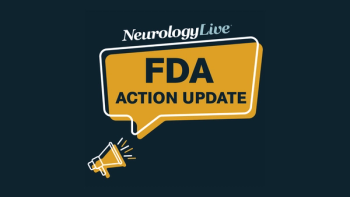
Investigational AD109 Meets End Points in Phase 3 LunAIRo Trial, Eyeing FDA Submission for Obstructive Sleep Apnea
Key Takeaways
- AD109 significantly reduced AHI and improved oxygenation in OSA patients, with effects sustained over 51 weeks.
- The drug aims to be the first oral pharmacotherapy for OSA, addressing neuromuscular causes of airway collapse.
Apnimed's AD109 shows promising results in treating obstructive sleep apnea, potentially revolutionizing care for millions with a once-daily oral medication.
Apnimed has announced positive data from its pivotal phase 3, 12-month LunAIRo trial (NCT05811247) testing investigational AD109, a combination of aroxybutynin and atomoxetine, as a potential treatment for obstructive sleep apnea (OSA). These findings, along with previously announced phase 3 data from the SynAIRgy trial (NCT05813275), are expected to support a new drug application submission to the FDA in early 2026.1
In LunAIRo, treatment with the AD109 led to significant reductions in apnea-hypopnea index (AHI), the primary end point, relative to those on placebo. At the 26-week mark, patients on the therapy achieved a mean reduction in AHI of 46.8% compared with reductions of 6.8% for placebo, which was statistically significant (P <.001). Notably, these effects were maintained until the end of the study, around week 51 (P <.001).
Throughout the study, AD109-treated patients demonstrated meaningful improvements in oxygenation, a secondary end point, as assessed by reductions in hypoxic burden (P <.0001) and oxygen desaturation index (P <.001) at week 26 and end of study (week 51). In addition, a significant proportion of patients achieved at least 50% reduction in AHI from baseline at week 26 (P <.0001) and at week 51 (P <.0001).
"With two large Phase 3 studies now demonstrating a consistent and significant efficacy profile for AD109, we are closer to delivering the first oral pharmacotherapy for over 80 million U.S. adults with OSA. Given the scale of unmet need in OSA, where the majority of patients remain untreated, we believe AD109, as a simple once-daily oral drug, has the potential to expand and reshape the treatment landscape, which would represent a significant commercial opportunity for Apnimed,"" Larry Miller, MD, chief executive officer at Apnimed, said in a statement.1
AD109 is a unique treatment that aims to become the first pharmacologic therapy for OSA by addressing the neuromuscular root cause of upper airway collapse. LunAIRo, a randomized, double-blind, placebo-controlled trial, comprised 660 adults with OSA who were intolerant of or refused continuous positive airway pressure (PAP) therapy. Spanning 64 centers, participants were randomly assigned to either AD109 (n = 329) or placebo (n = 331) and instructed to take their assigned treatment once daily before bedtime.
Treatment with AD109, a first-in-class anti-apneic neuromuscular modulator, led to improved OSA disease severity for 45.0% of participants at week 26 and 47.5% by week 51. Complete disease control, defined as an AHI of fewer than 5 events per hour, was achieved in 22.9% of AD109-treated patients at week 26 and 22.5% at week 51.
READ MORE:
LunAIRo had a mixture of different OSA severity levels, including mild (37%), moderate (33%), and severe (30%). In the data update, AD109 was considered well tolerated, with the most common treatment-emergent adverse events being mild or moderate in severity and consistent with previous studies. Notably, no serious adverse events in the study were attributed to AD109.
"The consistency of the promising findings across both the LunAIRo and SynAIRgy trials provides robust clinical evidence that AD109 meaningfully improved sleep apnea severity and oxygenation," study chair Sanjay Patel, MD, director of the UPMC Comprehensive Sleep Disorders Clinical Program, said in a statement.1 "This is the first time we’ve seen a once-daily oral medication demonstrate such significant, durable effects in a broad patient population with OSA."
The positive data from LunAIRo build on previously announced findings from SynAIRgy, a 646-patient study of AD109 in a broad range of OSA severities. Similar to LunAIRo, SynAIRgy met its primary end point, with AD109 demonstrating statistically significant changes in AHI relative to placebo over a 26-week treatment period (P = .001). Additionally, data from the prior study showed meaningful improvements in oxygenation, as assessed by hypoxic burden (P <.0001) and oxygen desaturation index (P = .001). Furthermore, 51.2% of treated patients experienced a reduction in OSA disease severity, and 22.3% achieved complete disease control.2
In the previously conducted phase 2 MARIPOSA trial (NCT05071612), AD109 demonstrated significant therapeutic benefits in a 211-patient cohort randomized to AD109, atomoxetine, or placebo. Treatment with AD109 (2.5 mg/75 mg) reduced the median AHI from 20.5 to 10.8 events/hour, a statistically significant improvement compared with placebo (P < .001).
Among those who completed MARIPOSA, 41% achieved an AHI below 10, 44% had a reduction greater than 50% from baseline, and 15% saw reductions of 80% or more. AD109 also improved daytime functioning, as measured by PROMIS-Fatigue (P < .05), and showed favorable trends in sleep impairment and disturbance scores. In contrast, atomoxetine alone worsened nighttime sleep quality and failed to improve daytime OSA symptoms, reinforcing the value of AD109 as a more comprehensive treatment approach.3
REFERENCES
1. Apnimed reports positive topline results from second phase 3 trial of AD109, reinforcing potential of first oral pill for obstructive sleep apnea. News release. July 23, 2025. Accessed July 23, 2025. https://apnimed.com/article/ad109toplinephase3results/
2. Apnimed announces positive topline results in the first landmark phase 3 clinical trial of AD109, an investigational once-daily oral pill for obstructive sleep apnea. News release. Apnimed. May 19, 2025. Accessed July 23, 2025. https://apnimed.com/article/ad109phase3toplineresults/
3. Apnimed presented positive phase 2b results on AD109, an investigational oral drug for obstructive sleep apnea, for the first time at ATS 2023. News release. Apnimed. May 21, 2023. Accessed July 23, 2025. https://apnimed.com/article/apnimed-presented-positive-phase-2b-results-on-ad109-an-investigational-oral-drug-for-obstructive-sleep-apnea-for-the-first-time-at-ats-2023/
Newsletter
Keep your finger on the pulse of neurology—subscribe to NeurologyLive for expert interviews, new data, and breakthrough treatment updates.































